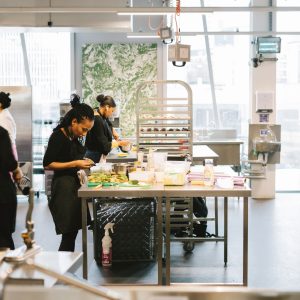In the realm of gastronomy, the industrial kitchen stands as the beating heart of culinary production, orchestrating the creation of delectable dishes on a grand scale. This dynamic and specialized environment fills in as the focal point where culinary mastery, state of the art innovation, and effective plan combine to satisfy the needs of restaurants, catering administrations, and food production facilities. We should embark on a deep dive into the industrial kitchen, investigating the components that make it the beat of culinary production.
- Productivity in Plan: Industrial kitchens are fastidiously intended to enhance work process and proficiency. Every last trace of space is carefully considered to accommodate various cooking stations, storage areas, and preparation zones. The layout is often planned in a logical and linear fashion, guaranteeing a smooth and continuous stream from raw fixings to the final plated masterpiece. Stainless steel surfaces, industrial-grade appliances, and modular gear add to a sterile and streamlined workspace, limiting the gamble of cross-contamination and enhancing overall cleanliness.
- Advanced Innovation Integration: The heartbeat of an industrial kitchen is fuelled by state-of-the-art innovation. Commercial-grade broilers, burners, and refrigeration units are outfitted with features that cater to high-volume production. Additionally, automated hardware like food processors, blenders, and slicers streamline redundant tasks, allowing gourmet experts and kitchen staff to zero in on additional intricate aspects of culinary creation.
- Scale of Production: Dissimilar to conventional kitchens, industrial kitchens operate on a lot larger scale, serving hundreds or even thousands of clients daily. This necessitates advanced planning, organization, and coordination among kitchen staff. From obtaining fixings in mass to executing exact piece control, the industrial kitchen environment is an ensemble of synchronized endeavors, guaranteeing that each dish fulfills the guidelines of taste, quality, and presentation.

- Safety and Compliance: Maintaining elevated expectations of safety and compliance is paramount in the industrial kitchen environment. Professional gourmet experts and kitchen staff go through thorough training to adhere to sanitation regulations and cleanliness practices. Industrial kitchens are furnished with safety features, for example, fire concealment frameworks, ventilation hoods, and crisis ways out to mitigate potential dangers.
- Team Collaboration: The industrial kitchen is a collaborative space where culinary professionals work as one to rejuvenate diverse dishes. The hierarchy of jobs, from chief gourmet experts to top assistant chefs and kitchen assistants, guarantees a seamless dissemination of obligations.
- Adaptability to Patterns: In the steadily developing culinary landscape, industrial kitchens display a remarkable adaptability to arising patterns. Whether it’s the ascent of plant-based food, the incorporation of global flavors, or the emphasis on sustainable practices, industrial kitchens are speedy to embrace and execute new culinary developments.
The industrial kitchen environment stands as a testament to the crossing point of artistry and functionality in the culinary world. From its effective plan and advanced innovation integration to the scale of production and emphasis on safety, the industrial kitchen encapsulates the obligation to conveying exceptional eating encounters. As the heartbeat of culinary production, it keeps on advancing, setting the musicality for gastronomic innovation and shaping the fate of the food business.





